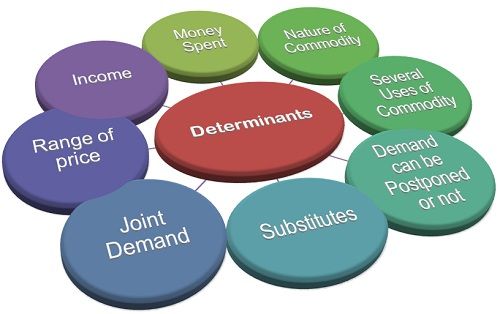Definition: The Elasticity of Demand is a measure of sensitiveness of demand to the change in the price of the commodity.
Determinants of Elasticity of Demand
Apart from the price, there are several other factors that influence the elasticity of demand. These are:
- Consumer Income: The income of the consumer also affects the elasticity of demand. For high-income groups, the demand is said to be less elastic as the rise or fall in the price will not have much effect on the demand for a product. Whereas, in case of the low-income groups, the demand is said to be elastic and rise and fall in the price have a significant effect on the quantity demanded. Such as when the price falls the demand increases and vice-versa.
- Amount of Money Spent: The elasticity of demand for a product is determined by the proportion of income spent by the individual on that product. In case of certain goods, such as matchbox, salt a consumer spends a very small amount of his income, let’s say Rs 2, then even if their prices rise the demand for these products will not be affected to a great extent. Thus, the demand for such products is said to be inelastic.
Whereas foods and clothing are the items where an individual spends a major proportion of his income and therefore, if there is any change in the price of these items, the demand will get affected.
- Nature of Commodity: The elasticity of demand also depends on the nature of the commodity. The product can be categorized as luxury, convenience, necessary goods. The demand for the necessities of life, such as food and clothing is inelastic as their demand cannot be postponed. The demand for the Comfort Goods is neither elastic nor inelastic. As with the rise and fall in their prices, the demand decreases or increases moderately.
Whereas the demand for the luxury goods is said to be highly elastic because even with a slight change in its price the demand changes significantly. But, however, the demand for the prestige goods is said to be inelastic, because people are ready to buy these commodities at any price, such as antiques, gems, stones, etc.
- Several Uses of Commodity: The elasticity of demand also depends on the number of uses of the commodity. Such as, if the commodity is used for a single purpose, then the change in the price will affect the demand for commodity only in that use, and thus the demand for that commodity is said to be inelastic. Whereas, if the product has several uses, such as raw material coal, iron, steel, etc., then the change in their price will affect the demand for these commodities in its many uses. Thus, the demand for such products is said to be elastic.
- Whether the Demand can be Postponed or not: If the demand for a particular product cannot be postponed then, the demand is said to be inelastic. Such as, Wheat is required in daily life and hence its demand cannot be postponed. On the other hand, the items whose demand can be postponed is said to have elastic demand. Such as the demand for the furniture can be postponed until the time its prices fall.
- Existence of Substitutes: The substitutes are the goods which can be used in place of one another. The goods which have close substitutes are said to have elastic demand. Such as, tea and coffee are close substitutes and if the price of tea increases, then people will switch to the coffee and demand for the tea will decrease significantly. Whereas, if there are no close substitutes for a product, then its demand is said to be inelastic. Such as salt and sugar do not have their close substitutes and hence lower is their price elasticity.
- Joint Demand: The elasticity of demand also depends on the complementary goods, the goods which are used jointly. Such as car and petrol, pen and ink, etc. Here the elasticity of demand of secondary (supporting) commodity depends on the elasticity of demand of the major commodity. Such as, if the demand for pen is inelastic, then the demand for the ink will also be less elastic.
- Range of Prices: The price range in which the commodities lie also affects the elasticity of demand. Such as the higher range products are usually bought by the rich people, and they do not care much about the change in the price and hence the demand for such higher range commodities is said to be inelastic.
Also, the lower range commodities have inelastic demand because these are already low priced and can be bought by any sections of the society. But the commodities in middle range prices are said to have an elastic demand because with the fall in the prices the middle class and the lower middle class are induced to buy that commodity and therefore the demand increases. But however, if the prices are increased the consumption reduces and as a result demand falls.
Thus, these are some of the important determinants of elasticity of demand that every firm should understand properly before deciding on the price of their offerings.


TAPIWA RAY NKOMO says
this is useful…l have learn a lot